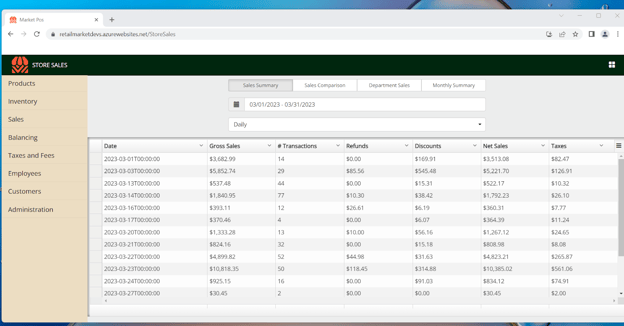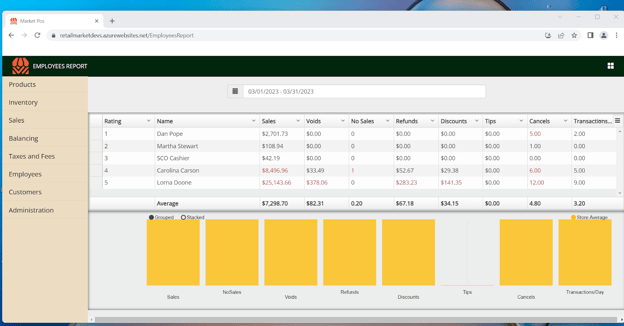POS Reports 101: 5 Essential Reports to Manage Your Grocery Store
As a grocery store owner or manager, you must keep track of a lot of data to make informed decisions about your business. If you’re not careful, it can quickly look like the inside of the Matrix.
But that's where point of sale (POS) reports come in handy. Your POS system generates business reports and can provide valuable insights into your store's performance, inventory management, and customer behavior.
Without real-time insights, you accept a high level of risk. While many of the challenges are apparent, inventory replenishment, reports on promotions, loyalty programs, and buying habits can deliver another level of value in your planning efforts.
In this article, we'll share five essential POS reports that every grocery store owner or manager should use to manage their business effectively.
Maximize Your Grocery Store's Potential with These Essential POS Reports
Reports are critical for running a successful grocery store. By tracking performance, profitability, compliance, and decision-making, owners and managers can gain valuable insights that inform their actions and help achieve their goals.
The reports included in this article come from our experience working with grocery stores, specialty markets, and grocerants of all sizes. With the information provided, they could turn insights into action and drive business growth.
We strongly recommend your reports integrate with your POS system for ease of use and a common operating picture.
Report 1: Sales Summary Report
The sales summary report is essential for grocery store owners and managers. This report provides an overview of your store's sales, including total revenue, number of transactions, and average transaction value.
One of the main advantages of the sales summary report is that it allows you to compare sales data across different periods, such as days, weeks, months, or years. This feature lets you identify trends and patterns in your store's sales and adjust your strategies accordingly.
For example, if your store's sales are consistently higher on Saturdays, schedule more staff on that day to handle increased demand.
Another benefit of the sales summary report is that it helps you identify opportunities to increase sales and revenue. For instance, if you notice that certain products are selling particularly well, promote them or place them in a more prominent location in your store.
Let’s look at an example to demonstrate the sales summary report’s total value.
Suppose that you notice that your store's sales have been declining over the past few months. By running a sales summary report, you can quickly identify which products contribute the most to your store's revenue and which are underperforming. With this information, you can adjust your pricing, promotions, and product placement to increase sales and revenue.
The sales summary report is a quick and effective way to get a holistic view of your grocery store and make sound strategic decisions.

Report 2: Inventory Report
The inventory report is another critical asset for grocery store owners and managers. This report helps you manage inventory well, and shows your store's inventory levels, including stock on hand, sold, and received.
A primary benefit of the inventory report is that it allows you to track inventory levels over time.
This feature enables you to identify which products are selling well and which ones need restocking. This data lets you adjust your ordering and restocking strategies to ensure you always have enough inventory to meet customer demand.
Similarly, if you notice that a particular product is not selling well, consider reducing your order quantity to minimize waste.
Inventory reports can also be valuable for budgeting and financial planning. They can assist when it comes to auditing and verifying the accuracy of the store’s financial records by providing details on inventory costs and turnover rates.
An inventory report isn’t just valuable for identifying logistical issues or problems with the supply chain. It can also give you a clear picture of the current value of your stock. This report helps forecast future budgeting requirements.

Report 3: Employee Performance Report
The employee performance report is valuable for optimizing your staff's performance. This report provides an overview of staff performance, including sales figures, the number of transactions, and the average transaction value.
Employee performance reports help you identify high-performing staff and areas where the team may need additional training or support. By analyzing sales data, you can determine which staff members consistently achieve high sales figures and recognize them for their excellent performance.
Related: 5 Simple Ways for Grocers to Retain Employees
Additionally, if you notice that certain staff members are consistently underperforming, consider providing them with additional training or support to help them improve.
Another advantage of the employee performance report is that it allows you to set sales targets and monitor progress toward achieving them.
By setting clear sales targets, you can motivate your staff to perform at their best and work towards achieving your store's goals. Monitoring progress towards achieving these targets allows you to identify areas where your team may need additional support or coaching to ensure they meet their targets.
Separate from just monitoring sales targets, managers can see how many voids, refunds, and discounts are coming from each associate. While this doesn’t necessarily point to the underperformance of a team member, it can highlight specific patterns that could be worth investigating further if necessary.

Report 4: Customer Purchase Report
The customer purchase report is critical for understanding customers' purchasing behavior. This report shows which products customers buy and how often they buy them. Analyzing this data lets you gain insights into your customers' preferences and tailor your marketing and promotions to specific customer segments.
One of the main benefits of the customer purchase report is that it helps you identify which products are popular with your customers and which may need to be promoted or discounted.
Also, by identifying which products are popular with specific customer segments, you can more rapidly influence your revenue with tailored promotional campaigns.
Customer purchase reports are also helpful for tracking individual sales. Separate from a loyalty program, you can identify customers exceeding certain spending thresholds with your grocery store and offer bonus deals for their patronage.

Report 5: Profit and Loss Report
The profit and loss report is one of the most common business reports you’ll ever find. This report provides a detailed breakdown of revenue and expenses for grocery stores, including the cost of goods sold, labor costs, and overhead.
Analyzing this data gives you insights into action when trying to improve your company’s bottom line.
Related: How Grocery Store Inventory Leads to Increased Profits: 4 Things to Know
One of the primary and most obvious benefits of the profit and loss report is that it helps you understand your store's profitability. With the data provided, you can identify which products and categories generate the most revenue and which expenses are the highest.
This information can help you make informed pricing, promotions, and cost management decisions.
Another advantage of the Profit and Loss Report is that it allows you to set financial goals and track progress toward achieving them. By setting clear financial goals, you can motivate your staff to work towards achieving them and ensure that your store's operations align with your financial objectives.
By monitoring progress towards achieving these goals, you can identify areas where you need to adjust your strategies to stay on track.
Tips For Using Customizable Reports
By tailoring reports to your store's specific needs, you can gain insights into your store's performance and make data-driven decisions to optimize your operations. Here are some tips for using customizable reports effectively:
Identify your KPIs: Before creating customized reports, it is essential to identify your key performance indicators (KPIs). These are the metrics that are most critical to your store's success. Focusing on your KPIs ensures that your reports provide the information you need to make informed decisions.
Segment data: To gain a deeper understanding of your store's performance, segment your data by various categories, such as product category, customer type, or store location. By analyzing data this way, you can identify trends and patterns that may be difficult to detect in a more general report.
Automate report generation: To save time and increase efficiency, consider automating the generation of your customizable reports. Automating allows you to generate reports regularly without requiring manual data entry or analysis. Many point of sale systems can automate report generation, so be sure to check if this is available in your system.
Evaluate and update reports: Once you have created customized reports, it is essential to evaluate their effectiveness regularly. Consider whether the reports provide the information you need to make informed decisions and identify areas where they may need to be updated or revised.
Harness the Power of Grocery POS Reports Today
POS reports are a valuable tool for managing a grocery store effectively. Using the essential reports we've outlined in this article, you can gain valuable insights into your store's performance, inventory management, and customer behavior.
These insights can help you make data-driven decisions, set goals, and track progress toward achieving them. But not every report holds the same value for each store.
Every store is unique and requires processes, specific reports, and necessary technology to run efficiently. As the person who knows your grocery store the best, check out the build & price tool to see what the perfect system for your store’s needs looks like.






 by Luke
by Luke


 by Joel
by Joel
